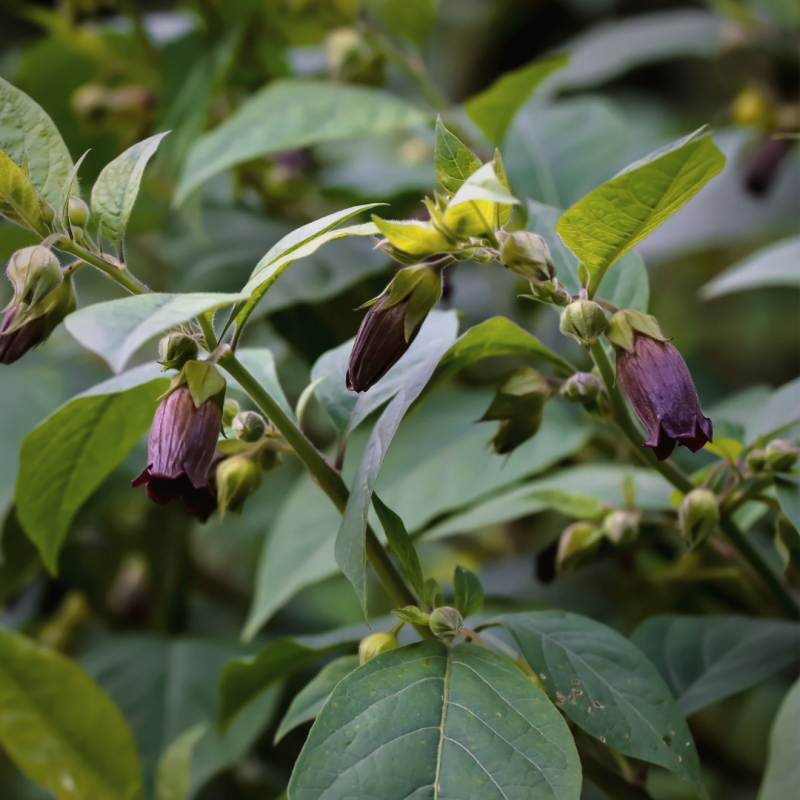
Named after Atropos, the oldest of the 3 Greek Fate goddesses who cuts the thread of life, Belladonna is a master of transformation and a plant of the Poison Path. It blurs the line between the physical and spiritual world, making it a powerful—and highly dangerous—ally for deep trance work, necromancy, and casting powerful, binding spells.
Before I get further here's
A Critical Reminder for the Modern Witch:
Belladonna is EXTREMELY POISONOUS and should never be ingested, smoked, or carelessly handled. Her magic is respected through study, reverence, and careful, non-contact ritual use only.
The German folklore surrounding Bella Donna (or Atropa belladonna) is a dark, intoxicating tapestry woven from beauty, madness, and the specter of death. Known in German as the Tollkirsche (Mad Cherry), the plant is a seductive yet lethal beauty, holding a potent, shadowy place in the heart of central European myth.

The Devil's Guard
In the dark forests and untamed edges of the land, the Bella donna was whispered to be the Teufelsbeere (Devil's Berry) and the Höllenkraut (Hell Herb). Legend claimed the very bush was guarded by the Devil himself. The sweet black berries were a forbidden lure and parents would warn their children that to pick them was to look the Prince of Darkness in the eye.
A tale suggests that a cunning witch or herbalist intent on harvesting the powerful poison would have to wait for the night of Walpurgisnacht (May Eve). To distract the infernal sentinel they would release a black hen upon which the Devil would fix his attention, leaving the prized poison briefly unguarded.

The Cosmetic "Beautiful Lady"
The most famous link is the plant's use as a beauty aid, primarily during the Italian Renaissance.
Dilated Pupils:
Women, particularly in Venice, would apply a diluted solution from the plant's juice (containing the alkaloid atropine) into their eyes. Atropine is a powerful mydriatic, meaning it forces the pupils to dilate, making them appear larger and darker.
This was considered attractive and seductive, creating a look described as "doe eyes." The large, black pupil was thought to signify allure and to mimic the dilation that occurs naturally during periods of excitement or attraction.
Blush and Complexion:
There are also reports that tonics or pastes from the plant were used on the face to achieve a flushed, rosy complexion, often by covering pallid skin.

The Rage of Wotan
The plant’s association with extreme psychological states led to its naming as the Wutbeere (Rage Berry). This name links it directly to the old Germanic god Wotan (Odin), the master of ecstasy, frenzy and battle rage.
It is a subtle but powerful echo of the time when warriors, like the fabled Berserkers, may have ingested its alkaloids to enter a fearsome, pain-numbing trance—a sacred, destructive madness that turned them into unstoppable instruments of rage on the battlefield.

The Sharpened Eye: A Dangerous Elixir
The most direct link between Bella donna and the hunter’s craft is its physiological effect on sight.
The Mydriasis of the Hunt:
The plant's primary alkaloid, atropine, is a potent mydriatic—it causes the pupils to dilate, or widen. While this effect is famously (and riskily) used for cosmetic appeal, its potential in the hunt lies in gathering more light.
It is suggested that hunters, particularly in Germany and up until the 19th century, would ingest minute, nearly homeopathic doses of the plant or its extracts.
The intent was to improve night vision and focus during a hunt, allowing the hunter’s eye to capture the faint, shifting light of the forest floor or the dark shape of game lurking in shadow.
The Double Edge:
This practice was a perilous gamble. The dosage is notoriously difficult to control. Even a slight miscalculation could quickly transform enhanced sight into:
Blurred Vision:
The dilated pupil struggles to focus on near objects, turning the landscape into a watery blur.
Delirium and Hallucinations: The hunter might gain "insight," but at the cost of genuine reality, confusing phantoms for quarry.
Respiratory Paralysis:
Ultimately, death, turning the hunter into the hunted's final prize.

The Flying Ointment
Perhaps the most potent piece of German folklore is the Bella donna’s role in witchcraft.
It was a key ingredient in the Hexensalbe (Witch Ointment) or Flugsalbe (Flying Ointment).
The belief was that witches, upon anointing themselves with this unguent, would achieve "spirit flight," soaring through the night air to the Witches' Sabbath.
The terrifying and vivid hallucinations caused by the plant's toxins were thus interpreted not as madness, but as literal, physical travel—a genuine voyage beyond the bounds of the mundane world on a broomstick, guided by the influence of the Mad Cherry.
The plant, therefore, stands as a mesmerizing figure in the German forest—the beautiful temptress whose kiss brings a terrifying vision and inevitable death, a living embodiment of the perilous boundary between this world and the mystical frenzy of the ancients.
Add comment
Comments